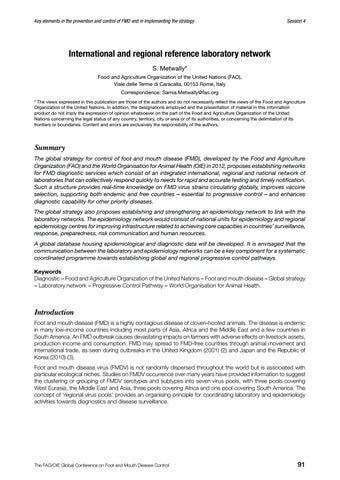Key elements in the prevention and control of FMD and in implementing the strategy
Session 4
International and regional reference laboratory network S. Metwally* Food and Agriculture Organization of the United Nations (FAO), Viale delle Terme di Caracalla, 00153 Rome, Italy Correspondence: Samia.Metwally@fao.org * The views expressed in this publication are those of the authors and do not necessarily reflect the views of the Food and Agriculture Organization of the United Nations. In addition, the designations employed and the presentation of material in this information product do not imply the expression of opinion whatsoever on the part of the Food and Agriculture Organization of the United Nations concerning the legal status of any country, territory, city or area or of its authorities, or concerning the delimitation of its frontiers or boundaries. Content and errors are exclusively the responsibility of the authors.
Summary The global strategy for control of foot and mouth disease (FMD), developed by the Food and Agriculture Organization (FAO) and the World Organisation for Animal Health (OIE) in 2012, proposes establishing networks for FMD diagnostic services which consist of an integrated international, regional and national network of laboratories that can collectively respond quickly to needs for rapid and accurate testing and timely notification. Such a structure provides real-time knowledge on FMD virus strains circulating globally, improves vaccine selection, supporting both endemic and free countries – essential to progressive control – and enhances diagnostic capability for other priority diseases. The global strategy also proposes establishing and strengthening an epidemiology network to link with the laboratory networks. The epidemiology network would consist of national units for epidemiology and regional epidemiology centres for improving infrastructure related to achieving core capacities in countries’ surveillance, response, preparedness, risk communication and human resources. A global database housing epidemiological and diagnostic data will be developed. It is envisaged that the communication between the laboratory and epidemiology networks can be a key component for a systematic coordinated programme towards establishing global and regional progressive control pathways. Keywords Diagnostic – Food and Agriculture Organization of the United Nations – Foot and mouth disease – Global strategy – Laboratory network – Progressive Control Pathway – World Organisation for Animal Health.
Introduction Foot and mouth disease (FMD) is a highly contagious disease of cloven-hoofed animals. The disease is endemic in many low-income countries including most parts of Asia, Africa and the Middle East and a few countries in South America. An FMD outbreak causes devastating impacts on farmers with adverse effects on livestock assets, production income and consumption. FMD may spread to FMD-free countries through animal movement and international trade, as seen during outbreaks in the United Kingdom (2001) (2) and Japan and the Republic of Korea (2010) (3). Foot and mouth disease virus (FMDV) is not randomly dispersed throughout the world but is associated with particular ecological niches. Studies on FMDV occurrence over many years have provided information to suggest the clustering or grouping of FMDV serotypes and subtypes into seven virus pools, with three pools covering West Eurasia, the Middle East and Asia, three pools covering Africa and one pool covering South America. The concept of ‘regional virus pools’ provides an organising principle for coordinating laboratory and epidemiology activities towards diagnostics and disease surveillance.
The FAO/OIE Global Conference on Foot and Mouth Disease Control
91
















